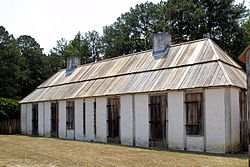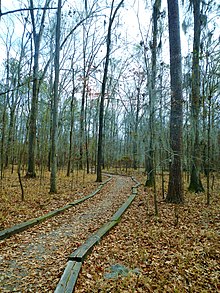Fort Toulouse and Fort Jackson
Fort Toulouse Site-Fort Jackson | |
 A portion of the modern Fort Toulouse reconstruction, taken in 2007. | |
| Nearest city | Wetumpka, Alabama |
|---|---|
| Coordinates | 32°30′12″N86°15′23″W/ 32.50333°N 86.25639°W |
| Built | 1814 |
| NRHP referenceNo. | 66000148 |
| Significant dates | |
| Added to NRHP | October 15, 1966[1] |
| Designated NHL | October 9, 1960[2] |
Fort ToulouseandFort Jacksonare two forts that shared the same site at the fork of theCoosa Riverand theTallapoosa River,nearWetumpka, Alabama.
Fort Toulouse
[edit]Fort Toulouse(Muscogee:Franca choka chula), also calledFort des AlibamonsandFort Toulouse des Alibamons,is a historicfortnear the city ofWetumpka,Alabama,United States,that is now maintained by theAlabama Historical Commission.The French founded the fort in 1717, naming it forLouis-Alexandre de Bourbon, comte de Toulouse.In order to counter the growing influence of theBritishcolonies ofGeorgiaandCarolina,the government ofFrenchLouisianaerected aforton the eastern border of the Louisiana Colony in what is now the state of Alabama.
The fort was also referred to as thePost of the Alabama,named after theAlabamatribe ofUpper CreekIndians,who resided just below the confluence of theCoosaandTallapoosarivers on the upper reaches of theAlabama River.
The number of troops ingarrisonvaried between 20 and 50French Colonial Marines.Living and working at the fort, the Marines traded extensively with the local CreekNative Americansand cultivated friendly relations with them. The French would tradeEuropeangoods such asFlintlockguns, ammunition, and gunpowder, iron tools, knives, glass beads, copper pots, and wool blankets in exchange for local food stuffs, fur anddeerskins.According to tradition, the French commander CaptainJean Baptiste Louis DeCourtel Marchandmarried the high-status Creek womanSehoyin about 1720. Later generations of Sehoy's descendants include the Creek chiefsAlexander McGillivray,andWilliam Weatherford,who inherited their status in thematrilinealtribe from their mothers'clans.
Due to the poor living conditions at the fort, which was neglected by the French government, the troops mutinied in 1722. They killed Captain Marchand and captured the other officers, tying them up before leaving the fort. The imprisoned officers managed to escape, and with the help of nearby Creek, they captured the mutineers and sent them toFort CondeinMobilefor punishment.
In 1735, the British builtFort Okfuskeefurther up the Tallapoosa River atOkfuskeeto compete with French trade at Fort Toulouse. Fort Okfuskee was garrisoned by theProvince of Georgiafrom 1735 to 1743 and by theProvince of South Carolinafrom 1744 to 1745.[3]Pierre de Rigaud, marquis de Vaudreuil-Cavagnial,the Governor ofFrench Louisiana,demanded that the commandant of Fort Toulouse notify theAbihkaandTallapoosasthat the French would withdraw trade from Fort Toulouse if they did not refuse to help build and destroy any constructed portions of South Carolina's Fort Okfuskee.[4]
By the early 1740s, conditions had improved at the fort. Many soldiers had married French women from Mobile or intermarried with the local Creek. They and other settlers developed numerous farms nearby, which led to improved food supplies. The humid climate caused deterioration of the fort by the late 1740s, and the French planned for a third fort to be built. Under the direction of Captain Francois Saucier, soldiers finished the reconstruction of Fort Toulouse about 1751. It cost nearly half of the military budget for the whole Louisiana colony.
In 1763 theTreaty of Parisended theFrench and Indian War.As the French had been defeated by the British and ceded their territory, the French garrison spiked their cannons and left forNew Orleansand an eventual return toFrancefor some. The British chose not to occupy the Fort, which eventually collapsed into decay. In 1776 the naturalistWilliam Bartramnoted visiting the area while studying local flora and fauna.
Fort Jackson
[edit]In the midst of theWar of 1812,an 1813 civil war in theCreek Nationled to an invasion by Americans fromTennessee,Georgia,andMississippi Territory.In the ensuingCreek Warof 1813–1814, GeneralAndrew Jacksoncommanded the combined American forces of Tennessee militia, U.S. regulars, and Cherokee and Creek Indian allies. Jackson defeated the Red Stick Creeks at theBattle of Horseshoe Bendin 1814, and afterwards initiated construction of a fort atop the site of the old French fort at the confluence of the Coosa and Tallapoosa rivers. The fort was intentionally built near the sacred Creek site known as theHickory Ground.[5]Jackson then temporarily traveled to Washington and in his absence, the fort was named "Jackson" in his honor. After Jackson's return, he imposed theTreaty of Fort Jacksonupon both the Northern Creek enemies and the Southern Creek allies, wresting 20,000,000 acres (8,100,000 ha) from all Creeks for white settlement.
The site was declared aNational Historic Landmarkin 1960.[2][6]
During the American Bicentennial in the mid-1970s an attempt was made to reconstruct Fort Toulouse, however the replica was incorrectly built upon the outline of the much larger Fort Jackson.
Fort Toulouse-Fort Jackson State Historic Site
[edit]
The site was declared aNational Historic Landmarkby the Department of Interior in 1960.[2][6]During theAmerican Bicentennial,local groups supported reconstruction of Fort Toulouse. But the replica was incorrectly built upon the outline of the much larger Fort Jackson rather than the historic French fort.
In the 1980s the park was acquired by theAlabama Historical Commission.It dismantled the incorrect replica and constructed a replica of Fort Toulouse near its original site. This will allow for a future reconstruction of Ft. Jackson on its site (occupied successively by the two forts).Archeologicalexcavations have been continuing at the site, supervised by Dr. Craig Sheldon ofAuburn Universityat Montgomery.
TheFort Toulouse-Fort Jackson State Historic Sitehasliving historyprograms to portray and interpret the lives of the Creek inhabitants, the French colonists and the U.S. military troops associated with the War of 1812. The fort is located southwest of Wetumpka, off ofU.S. Highway 231.
The site also features theTaskigi Moundor "Mound at Fort Toulouse – Fort Jackson Park" (1EE1) a prehistoricSouth Appalachian Mississippian culturepalisadedvillage with a centralplazaarea, and a rectangularplatform mound.The mound is one of the locations included on theUniversity of Alabama Museums"Alabama Indigenous Mound Trail".[7]
TheWilliam Bartram Arboretumis anarboretumlocated at 2521 Fort Toulouse Road, nearWetumpka, Alabama,in theUnited States.In the 1980s the park became a property of theAlabama Historical Commissionand the incorrectly built fort was dismantled and recycled to partially construct a "correct" replica of Ft. Toulouse adjacent to the original site, allowing for a future reconstruction of Ft. Jackson on the actual site once occupied by both forts.
References
[edit]- ^"National Register Information System".National Register of Historic Places.National Park Service.January 23, 2007.
- ^abc"Fort Toulouse Site-Fort Jackson".National Historic Landmark summary listing.National Park Service. Archived fromthe originalon 2008-01-11.Retrieved2007-10-21.
- ^Wood, Brian M. (1984). "Fort Okfuskee: A British Challenge to Fort Toulouse aux Alibamons". In Waselkov, Gregory A. (ed.).Fort Toulouse Studies.Montgomery, Alabama: Auburn University at Montgomery. p. 41.
- ^Wood 1984,pp. 47.
- ^A. J. Langguth, Union 1812, 2006, p. 287
- ^abCecil McKithan (June 29, 1989)National Register of Historic Places Inventory-Nomination: Fort Toulouse / Fort Jackson,National Park Service andAccompanying 1 photo, undated.
- ^"Mound at Fort Toulouse – Fort Jackson Park".University of Alabama.
Further reading
[edit]- Heldman, Donald P. "Fort Toulouse of the Alabamas and the Eighteenth-Century Indian Trade".World Archaeology5.2 (1973): 163-169.
External links
[edit]- Fort Toulouse-Fort Jackson State Historic Site- official site
- [1]Fort Toulouse/Fort Jackson - Alabama Historical Commission
- Fort Toulouse website
- Google books (p. 190)
- Forts in Alabama
- War of 1812 forts
- Creek War
- Pre-statehood history of Alabama
- 1814 establishments in Mississippi Territory
- Military installations established in 1814
- National Historic Landmarks in Alabama
- Buildings and structures in Elmore County, Alabama
- Parks in Alabama
- Protected areas of Elmore County, Alabama
- Alabama State Historic Sites
- National Register of Historic Places in Elmore County, Alabama




